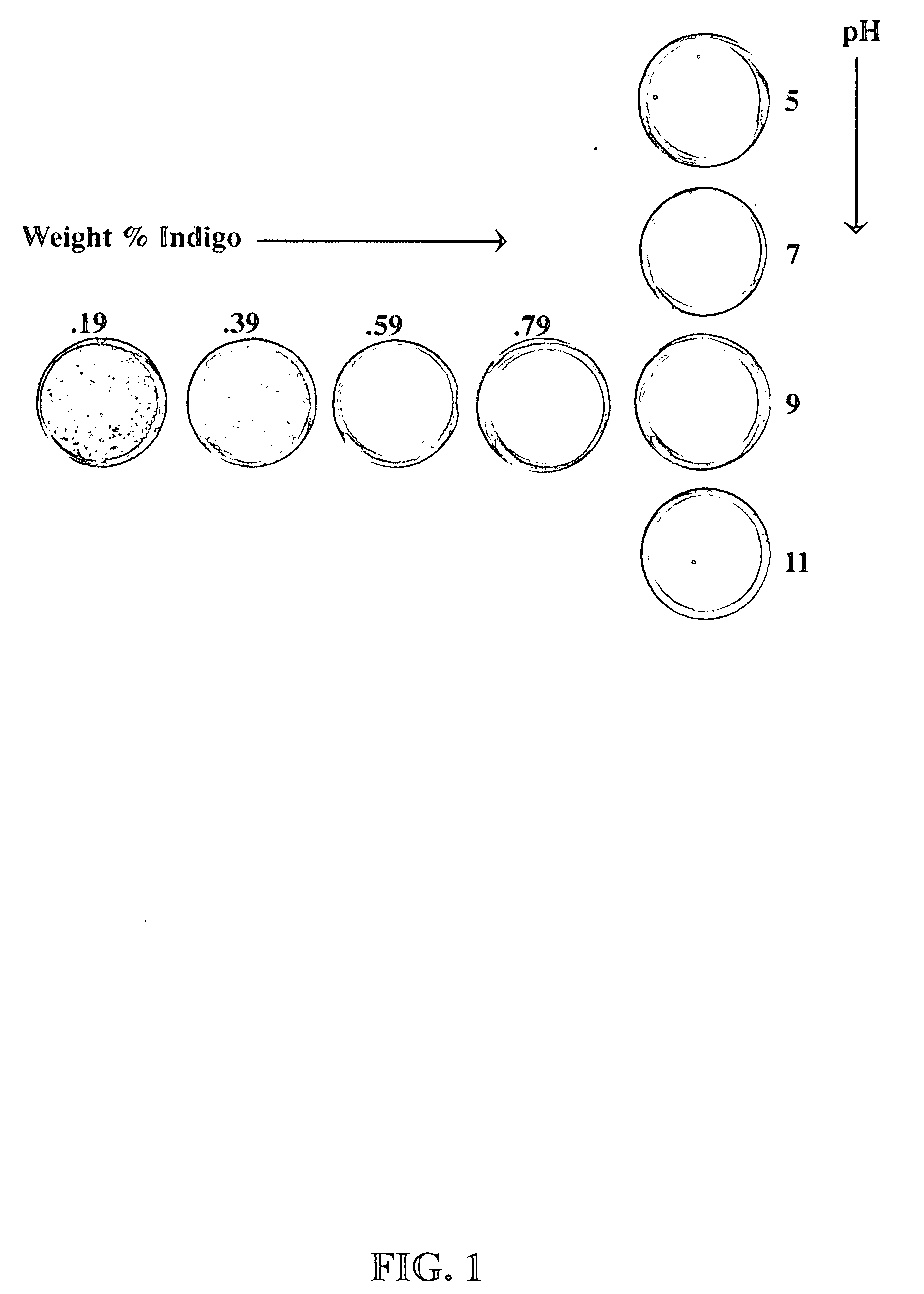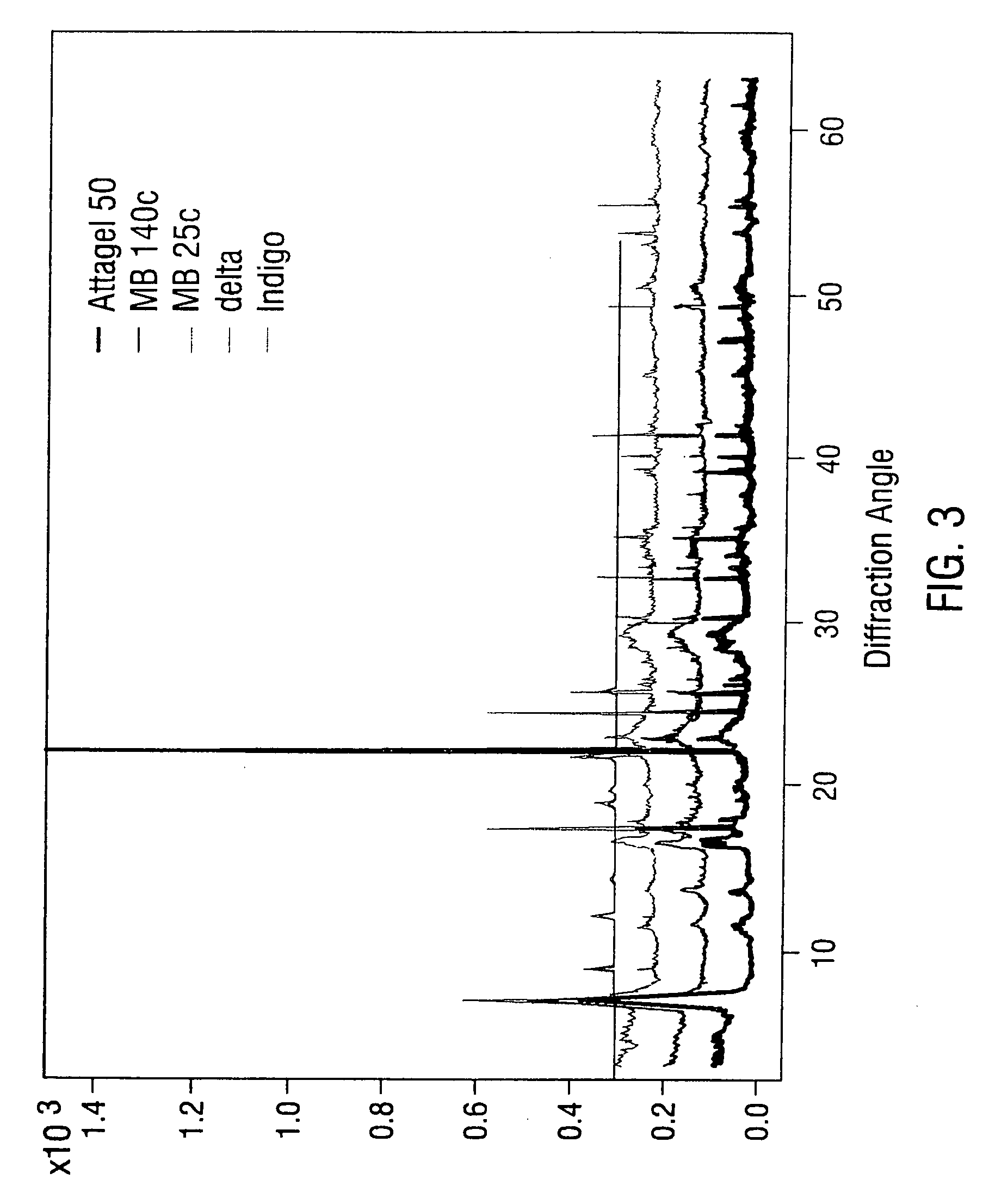Color compositions
a color composition and composition technology, applied in the field of paints, can solve the problems of lack of understanding regarding the chemistry of producing stable and nontoxic paint systems
- Summary
- Abstract
- Description
- Claims
- Application Information
AI Technical Summary
Benefits of technology
Problems solved by technology
Method used
Image
Examples
##ic example 1
Prophetic Example 1
Indigo Derivatives Concentration Experiments
[0048] A 0.05 g sample of indigo derivatives (from BASF) was suspended in ˜50 ml of water. Sodium hydrosulfite, 0.03 g, and 15 drops of 1 M NaOH were added to the solution to reduce the indigo derivative. The solution was heated to 90° C. while stirring with a magnetic stirrer. The solution remained blue, at which point an additional 0.1 g of sodium hydrosulfite was added. The solution turned clear indicating that the indigo derivative had been reduced and was now soluble. The leucoindigo derivative was then poured over 5 g of palygorskite clay, and was stirred. Immediately upon contact with the clay and being exposed to air, the solution turned dark blue. The solution was placed in the oven at 125° C. for four days, at which point it resembled the color of organic / inorganic complex. The hue was slightly lighter and less intense than that of original organic / inorganic complex; hence, a series of clay pigments were prepa...
example 2
pH Experiments of Synthetic Organic / Inorganic Complex
[0050] Synthetic samples were prepared using either sodium hydroxide or sodium hydrochloride to prepare the samples in acidic or basic solution. For the pH studies, 0.1 g of indigo was ground with 5.0 g of clay four times to obtain four samples. To each ground mixture was added 100 ml DI water, and dropwise either 1 M NaOH, or 1 M HCl to obtain solutions with pH's of 4, 7, 9, and 11. The pH of the system was monitored with a pH meter that had been calibrated with buffers of pH 4, 7, and 11.
[0051] As shown in FIG. 1, the colors arranged horizontally, prepared with increasing concentrations of indigo, visually range from a pale bluish-green to a darker grayish blue-green. The variations of color seen in the vertical direction range from grayish blue-green under basic conditions to brighter, vibrant blues at neutral to acidic pH. Visually, the organic / inorganic complex prepared with the highest percentage (2%) of indigo derivatives...
example 3
Mixing of Organic / Inorganic Complex
[0052] Synthesis of organic / inorganic complex requires grinding or milling. It is known that under mechanical milling the fiber bundles can disaggregate and the ends become splayed. At the frayed ends, the bond strength of the tetrahedral layers is reduced such that the guest indigo molecule can enter the channel and pry apart the weaker layers to create a superlattice structure. Furthermore, as organic molecules interact with the clay surface there is a reorientation of the OH-groups which initiates the elastic deformation of the interlayer spacing, thus allowing penetration of the guest molecule. The inventors have solid state NMR and IR evidence of how the OH-groups on the palygorskite surface reorient during this process. This reorientation, or change in Si-O-Si bond angle is directly related to the adsorption of indigo derivative to the external surface.
PUM
| Property | Measurement | Unit |
|---|---|---|
| particle size | aaaaa | aaaaa |
| particle size | aaaaa | aaaaa |
| particle size | aaaaa | aaaaa |
Abstract
Description
Claims
Application Information
 Login to View More
Login to View More - R&D
- Intellectual Property
- Life Sciences
- Materials
- Tech Scout
- Unparalleled Data Quality
- Higher Quality Content
- 60% Fewer Hallucinations
Browse by: Latest US Patents, China's latest patents, Technical Efficacy Thesaurus, Application Domain, Technology Topic, Popular Technical Reports.
© 2025 PatSnap. All rights reserved.Legal|Privacy policy|Modern Slavery Act Transparency Statement|Sitemap|About US| Contact US: help@patsnap.com



